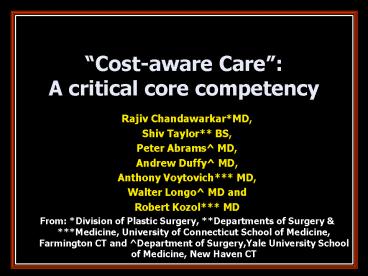Costaware Care: A critical core competency - PowerPoint PPT Presentation
1 / 24
Title: Costaware Care: A critical core competency
1
Cost-aware Care A critical core competency
- Rajiv ChandawarkarMD,
- Shiv Taylor BS,
- Peter Abrams MD,
- Andrew Duffy MD,
- Anthony Voytovich MD,
- Walter Longo MD and
- Robert Kozol MD
- From Division of Plastic Surgery, Departments
of Surgery Medicine, University of
Connecticut School of Medicine, Farmington CT and
Department of Surgery,Yale University School of
Medicine, New Haven CT
2
Background
- FACT
- The healthcare climate is rapidly changing from
one that used to be a blind-to-cost delivery
system to one that is under national scrutiny due
to rising healthcare costs
3
Background
- FACT
- 77 million Americans will march towards Medicare
eligibility by 2011. - Until then, and thereon, billions of healthcare
obligations will have to be met.
4
Background
- FACT
- Going forward evolving healthcare delivery
systems will need to sharply focus upon two
fundamental issues - cost and quality of care.
5
Background
- FACT
- Newer initiatives including the
Pay-for-Performance program initiated by the CMMS
and Federation of Hospitals aim at rewarding
healthcare systems that deliver the best care at
the lowest cost and seek to disincentivize
systems that do not.
6
Background
- FACT
- In this competitive and charged environment, only
physicians that are willing to learn about the
strengths and weaknesses of healthcare systems
and can deploy them effectively can elicit
improvements in the patient care.
7
Background
- Systems-Based Practice (SBP) is the sixth
competency defined by the ACGME Outcomes Project.
8
Background
- Specifically, SBP requires that "Residents
demonstrate an awareness of the larger context
and system of health care and the ability to
effectively call on system resources to provide
care that is of optimal value."
9
Background
- Rising healthcare costs and new
pay-for-performance initiatives make it
imperative that SBP include education on the
costs of care in general as well as that of
postoperative complications.
10
Study Aim
- Improve resident core-competence in terms of
their ability to accurately estimate costs of
postoperative complications.
11
Methods
- This prospective, IRB-approved study included 53
participating general surgery residents from two
institutions University of Connecticut- and the
Yale University School of Medicine.
12
Methods
- The 3-step educational exercise involved
- Step-1 Residents were provided three clinical
vignettes detailing common post-surgical
complications and their specific treatment
measures, and asked to assign cost-estimates for
the total treatment for each vignette - Step-2 Each resident was given a pocket-size
card listing hospital charges and asked to
periodically review it during the course of two
weeks. - Step-3 They were re-tested (without access to
the cost-card) for the clinical scenarios as in
Step1
13
Figure 1 Chandawarkar et al
Experimental Design
Step 2 Introduction of Cost Card
D1
D2
Step 1 3 Collection of Data (Observed
Values)
Data Analysis
(Observed
Value - True Value) Percent Error
--------------------------------------------------
x 100
True Value
14
Methods
- Estimates for the same clinical vignettes in
Step-1 recorded. - Cost-estimates for Step-1 and Step-3 were
compared using the paired-t test (for the
entire group) and ANOVA (for differences
categorized by PGY-level or type of vignette).
15
Methods
- Specific questions addressed were
- is there is a difference between the baseline
cost-estimates and the actual cost - does introduction of the cost-card improve their
performance - do the responses correlate to PGY-level or to the
clinical vignette.
16
Figure 2 Chandawarkar et al
PGY Distribution
PGY
17
Figure 3A Chandawarkar et al
Results Percentage Error
18
Figure 3B Chandawarkar et al
Results
- 32
- 35
- 38
19
Figure 4 Chandawarkar et al
Results
20
Chandawarkar et al
Results Distribution of Error vs Case Scenario
21
Chandawarkar et al
Results Distribution of Error vs PGY level
22
Results
- There was a statistically significant difference
between the baseline cost-estimates (before
introduction of the cost-card) and the actual
cost of the treatment (plt0.05). - Introduction of the cost-card resulted in a
statistically significant improvement between the
cost-estimates before and after the intervention
(p0.002) with a drop in average percentage error
by 35 (range 3238). - Level of PGY-training or type of test-vignette
(by ANOVA) did not appear to be significant
factors in the changes in the cost estimates.
23
Conclusions
- There is an inherent lack of awareness in the
resident group about the cost of complications in
real dollar - values.
- Introduction of an educational tool such as a
cost-card measurably improves their overall
understanding of cost of care.
24
Conclusions
- The interventional measures described in this
study are simple, inexpensive and can be easily
incorporated into the residency curriculum. - In the current cost-conscious healthcare
climate, these educational measures are timely,
proactive ways to strengthen a core competency
vital to every resident-training program.































